Journal of Yoga & Physical Therapy
Open Access
ISSN: 2157-7595
ISSN: 2157-7595
Research - (2024)Volume 14, Issue 1
Background: The trunk plays a vital role in limb excursion and manipulation. Hence core muscle strength invariably affects the performance of the upper extremity skills. Thus this study tried to determine the correlation between core muscle strength and handwriting speed among College students.
Methodology: 100 subjects were selected based on the selection criteria. Initially the core muscle strength was assessed using double leg lowering test then the core muscle endurance was assessed using McGill trunk endurance test. Then the handwriting speed was assessed using handwriting speed test.
Results: Pearson’s correlation analysis was done to find the relationship between handwriting speed and core strength, r value was calculated between double leg lowering test, Mcgill trunk endurance test and handwriting speed test. The level of significance was set at p<0.05. The p value calculated showed a significant relationship between the variables.
Conclusion: This study concludes that there is a moderate positive correlation between the core muscle strength and handwriting speed among college students.
Core muscle strength; Double leg lowering test; Handwriting speed test; McGill trunk endurance test
Writing is an essential function for students at homes, schools and college. A student spends nearly up to 50% of their day in performing writing tasks. Writing legibly and efficiently helps in accomplishing high level academic activities and to communicate important information to parents, teachers and peers. Handwriting speed is an integral component in writing task. It is the ability by which one is able to express knowledge about different subjects, it is a basic and essential life skill used as a form of expression and communication. It is an integrated process which involves close coordination between musculoskeletal and nervous system. It is a complex, fine motor skill, where fine, precise, coordinated movements occur in the extremity. Handwriting depends on anatomy of extremity, general health, mental perceptiveness, writing device, stable base of support, strength of shoulder muscles, posture, age [1].
A study found that students were seven times more likely to recall, revise class material a week after it was presented if the information was handwritten in their notes. Many studies state slow handwriting can lead to loss of motivation, evasion of school work. It increases time required for completing assignments. Slow writing affects the overall performance, it reduces confidence of student, it evades academic work and cause learning difficulties [2].
Core acts like a muscular corset, which functions as a whole unit to stabilize the body and spine with and without limb movement [3]. Core acts as the centre most part of the functional kinetic chain. Some researchers describe core as a double walled cylinder with abdominals as the front, paraspinals and gluteals as the back, diaphragm as the roof, pelvic floor and hip girdle at the bottom and hip abductors and rotators on the sides, all these insert into thoraco lumbar fascia which connects the upper and lower extremities with core which joins the superior inferior parts and right left parts of the abdomen. The core musculature consist muscles of trunk and pelvis which transfer energy from large torso to smaller extremities during many sports activities. If the core stability is less but extremities are strong there will be less force production and inefficient movement patterns [4].
The functional ability of core could affect performance and handwriting speed of the student. A study stated that a fatigue core has a significant effect on force produced by shoulder joint, this may affect the proximal distal principle of functioning. A weak core affects the posture of the child while sitting, resulting in a slump over the desk affecting the writing. A study found that core strength affects the posture in children, another study supported the statement and stated that abdominal muscle endurance was reduced in subjects having lordotic posture leading to low back pain. Core also affects the fine motor skills off children thus affecting the writing speed. A study found a relation between core strength and fine motor skills in children which were seen as significant correlated. Core also affects the writing speed by altering the hand eye coordination. Research states that core muscle strength affects the performance of the upper extremity skills. If the core is weak then the task involving hand eye coordination is also affected [5].
Hundred subjects were taken including both males and female college students from Amity university, Noida. All students taken were non-athletes, following sedentary lifestyle ranging within the age of 18-25 years [6].
Inclusion criteria:
• Subject with age between 18-25 years.
• Both gender male and females.
• Both right and left hand dominant.
• College going students.
Exclusion criteria:
• Recent upper limb fractures.
• Conditions affecting upper limb joints like rheumatoid
arthritis.
• Brachial plexus injury.
• Going to gym for more than 6 months.
• Lower back pathologies.
• Posture deficit like scoliosis, kyphosis, lordosis.
• Trained athletes.
Parameters:
• Core muscle endurance.
• Core muscle strength.
• Handwriting speed.
Tools:
• McGill trunk endurance test in seconds.
• Double leg lowering test in degrees.
• Handwriting speed test in letters per minute.
First all the subjects were shortlisted by exclusion criteria. The subjects completed the demographic sheet, were informed of the testing protocol and signed the informed consent. The core strength of the subject was measured starting with Mcgill trunk endurance test and double leg lowering test. Then the handwriting speed was measured using handwriting speed test [7].
Double leg lowering test: The subject lies in supine with their hips flexed to 90* and blood pressure cuff is placed under L4-L5 region. Cuff is inflated till 40 mmhg. Then the subject is told to lower his legs where there is lowering of pressure the angle of hip is noted [8].
McGill’s trunk muscle endurance test: Three tests are performed under this flexion endurance test, lateral bridge and extension endurance test. Lateral bridge subject performs side plank time is noted. Flexor endurance test-the subject sits at 60* with both hips and knees at 90* arms are folded across the chest. Time is noted till the position is maintained. Extensor endurance test-the subject lies in prone over the edge of couch. Arms are placed across the chest. Time is noted till the position is maintained [9].
Measuring handwriting speed: The test was started with subject sitting on chair with hip and knees at 90 degrees with table placed at proper level. The subject was given a sentence ‘The quick brown fox jumps over a lazy dog’ and was asked to copy this sentence on a A4 size sheet in 3 minutes. At the end the number of letters were counted and writing speed was calculated [10].
The components analyzed were handwriting speed and core endurance of left lateral muscle group. The data shows a moderate positive correlation between the two and a significant p value. Thus more will be the endurance more will be the writing speed (Tables 1 and 2) [11].
| Variables | |
| Total strength | 100 |
| Gender | |
| Male | 25 |
| Female | 75 |
Table 1: Demographic detail.
| Mean handwriting speed | Mean lateral bridge left | SD | Pearson correlation® | P-value |
|---|---|---|---|---|
| 108.27 | 35.42 | 40.96 | 0.627 | 0.000015* |
Note: *P<0.05 indicates significant correlation
Table 2: Correlation between handwriting speed and lateral bridge left side.
The components analyzed were handwriting speed and core endurance of right lateral muscle group. The data shows a moderate positive correlation between the two and a significant p value. Thus more will be the endurance more will be the writing speed (Figure 1 and Table 3) [12].
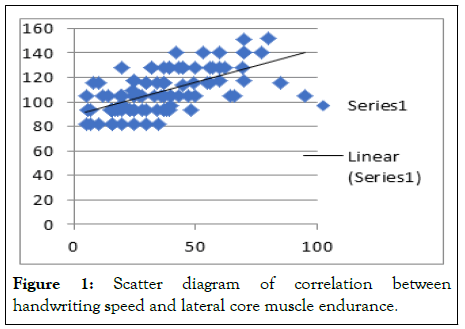
Figure 1: Scatter diagram of correlation between handwriting speed and lateral core muscle endurance.
| Mean handwriting speed | Mean lateral bridge right | SD | Pearson correlation (r) | P-value |
|---|---|---|---|---|
| 108.27 | 38.7 | 40.14 | 0.563 | 0.000015* |
Note: *P<0.05 indicates significant correlation
Table 3: Correlation between handwriting speed and lateral bridge right side.
The components analyzed were handwriting speed and core strength of extensor Muscle group. The data shows a moderate positive correlation between the two and a significant p value. Thus more will be the endurance more will be the writing speed (Figure 2 and Table 4) [13].
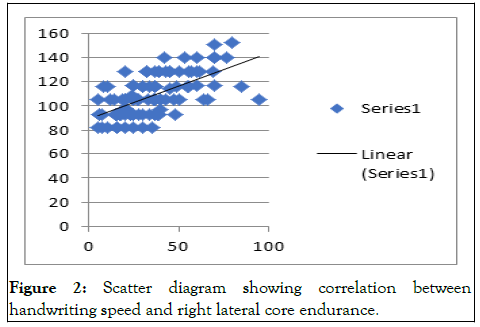
Figure 2: Scatter diagram showing correlation between handwriting speed and right lateral core endurance.
| Mean handwriting speed. | Mean extensor endurance | SD | Pearson correlation (r) | P-value |
|---|---|---|---|---|
| 108.27 | 36.76 | 41.2 | 0.568 | 0.00001* |
Note: *P<0.05 indicates significant correlation
Table 4: Correlation between Handwriting speed and extensor endurance test.
The components analyzed were handwriting speed and core endurance of flexor muscle group. The data shows a moderate positive correlation between the two and a significant p value. Thus more will be the endurance more will be the writing speed (Figure 3 and Table 5) [14].
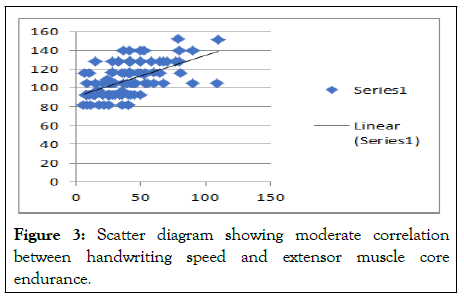
Figure 3: Scatter diagram showing moderate correlation between handwriting speed and extensor muscle core endurance.
| Mean handwriting speed | Mean flexor endurance test | SD | Pearson correlation (r) | P-value |
|---|---|---|---|---|
| 108.27 | 56.86 | 34.89 | 0.643 | 0.000015* |
Note: *P<0.05 indicates significant correlation
Table 5: Correlation between handwriting speed and flexor endurance test.
The components analyzed were handwriting speed and core strength. The data shows a moderate negative correlation between the two and a significant p value. As this is measured in degrees so lower will be the range of motion of hip flexion stronger will be the core and more will be the writing speed (Figures 4,5 and Table 6).
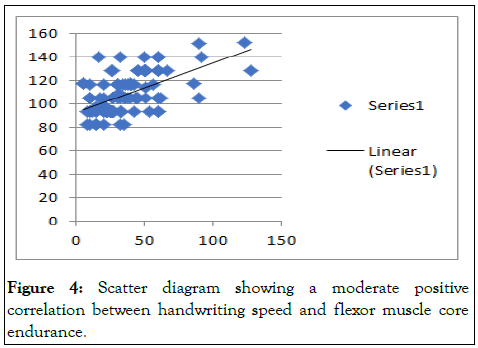
Figure 4: Scatter diagram showing a moderate positive correlation between handwriting speed and flexor muscle core endurance.
| Mean handwriting speed | Mean double leg lowering test | SD | Pearson correlation (r) | P-value |
|---|---|---|---|---|
| 108.27 | 57.98 | 29.1 | -0.689 | 0.00001* |
Note: *P<0.05 indicates significant correlation
Table 6: Correlation between handwriting speed and double leg lowering test.
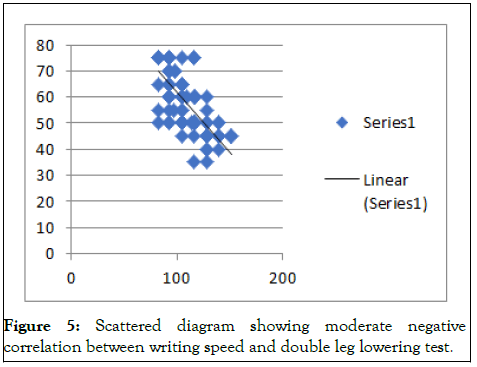
Figure 5: Scattered diagram showing moderate negative correlation between writing speed and double leg lowering test.
The purpose of this study was to find a correlation between core strength and handwriting speed among college students. It is already been stated that core plays an essential role as the centre of all functional motion within the kinetic chain. However what effect core strength has on writing speed is yet to be discovered. This study improves knowledge on the factors affecting writing speed by introducing new information to the title.
It was hypothesized that there would be a positive correlation between core strength and writing speed. In this study, data analysis demonstrated a positive correlation of handwriting speed and core strength, thus the hypothesis was stated true. This demonstrated that an individual having more core strength will have more writing speed. Core strength affects the posture because weaker core strength results in slouched posture, which further affects the 90-90 degree posture which is required for support while writing, due to which the writing speed is affected. Absence of early postural control could affect prehension or the ability to grasp. In this analysis of partial correlation for the study objectives, the variable of gender was controlled this was done to remove the effects of gender and have a clear relation between the variables of interest.
In support of our findings did a similar study and reported the trunk control and core stability are required for improving the fine motor skills. This confirms that core strength affects the writing speed among students, indicating that a physical therapist could work on core strength and core muscular endurance activities, which may improve special fine motor skills such as handwriting, copying. A therapist could also focus on improving posture control skills by improving core stability this improves cutting ability or accuracy of filling shapes with colors. In contrast of this study, out that writing speed is not only affected by posture and core stability it is also affected by strength of shoulder muscles, mental perceptiveness, age and stable base of support.
Based on the results, the study has clearly determined a significant effect of core muscles strength and endurance on handwriting Speed in healthy individuals. The evidence of decrease handwriting Speed due to poor core strength and core endurance has highlighted the need for such individuals to undergo training for core muscles. The outcome of this study acts as a tool for clinician to assess core strength of children as well as adults and inculcate the importance of core strength in there day to day practice. This study can further support the idea for including a core stability exercise program in schools and colleges.
Further research is needed to provide evidence that state a relation between postural control and core stability and how core strength exercise program in therapy improve fine motor skills. This can be done by implementing an interventional approach with college students performing certain core strengthening exercises like curl ups, sit ups, planks, side planks, leg raises, and crunches then testing the handwriting speed to see if it has improved.
There are certain limitations to the study performed the sample size taken was hundred subjects, male subjects taken were less, convenient sampling was used, subjects taken had only two people having left hand dominance thus limiting the ability to find effect of core strength on handwriting speed in right hand dominance population.
The outcome of this study act as a tool for clinician to assess core strength of children as well as adults and inculcate the importance of core strength in there day to day practice. This study can further support the idea for including a core stability exercise program in schools and colleges.
Institutional NTCC Committee, Amity University.
Self.
Nil.
[Crossref] [Google Scholar] [PubMed]
[Google Scholar] [PubMed]
[Crossref] [Google Scholar] [PubMed]
[Crossref] [Google Scholar] [PubMed]
[Crossref] [Google Scholar] [PubMed]
[Crossref] [Google Scholar] [PubMed]
[Crossref] [Google Scholar] [PubMed]
[Crossref] [Google Scholar] [PubMed]
Citation: Butail R (2023) Correlation between Core Muscle Strength and Handwriting Speed among College Students. J Yoga Phys Ther. 14:407.
Received: 17-Jul-2020, Manuscript No. JYPT-23-5456; Editor assigned: 22-Jul-2020, Pre QC No. JYPT-23-5456 (PQ); Reviewed: 05-Aug-2020, QC No. JYPT-23-5456; Revised: 15-May-2024, Manuscript No. JYPT-23-5456 (R); Published: 12-Jun-2024 , DOI: 10.35248/2157-7595.24.14.407
Copyright: © 2023 Butail R. This is an open-access article distributed under the terms of the Creative Commons Attribution License, which permits unrestricted use, distribution, and reproduction in any medium, provided the original author and source are credited.